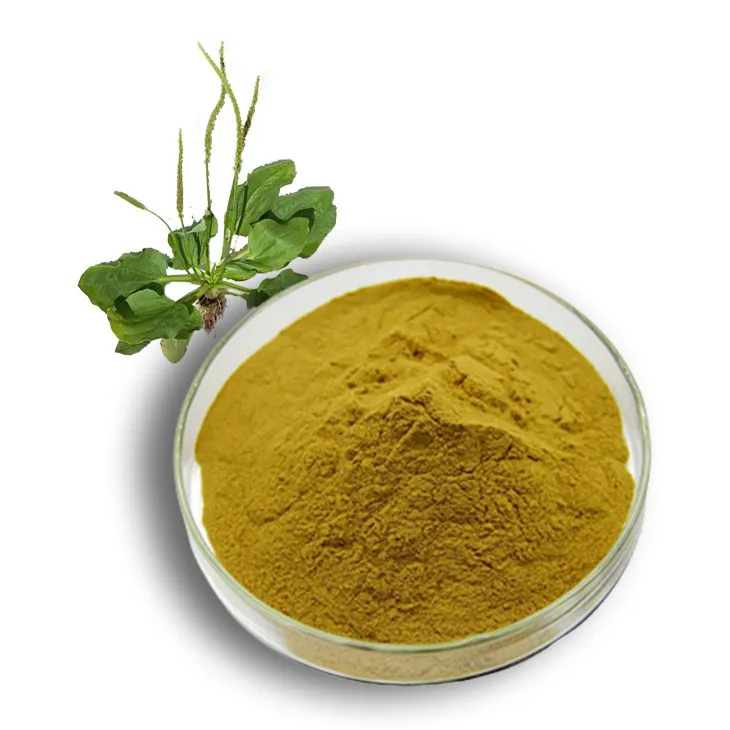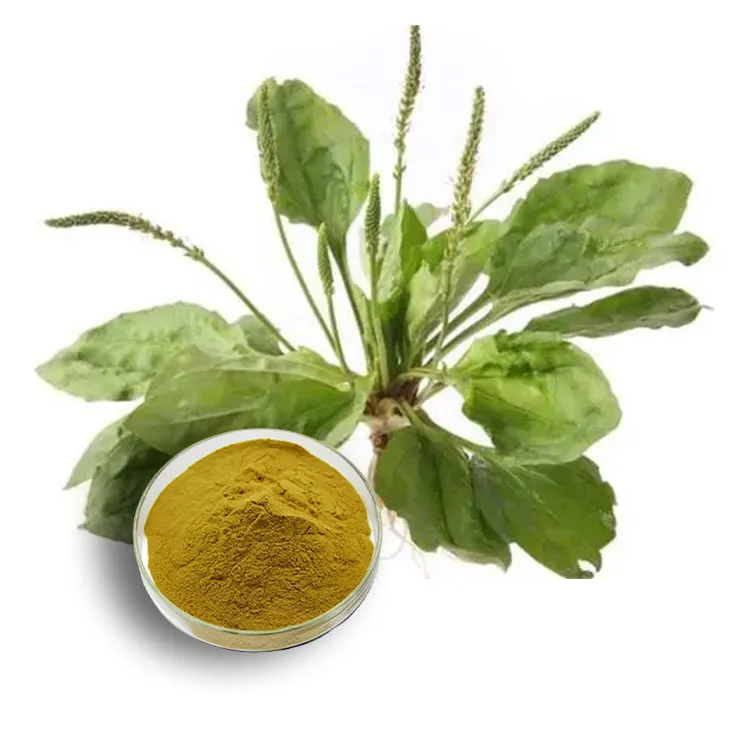- 0086-571-85302990
- sales@greenskybio.com
The best sources of natural plantain extracts.
2024-12-01

Introduction
Plantain extract, which is obtained from the plantain plant, has been recognized for its numerous health benefits. It has been used in traditional medicine for centuries and is now gaining popularity in modern health and wellness applications. This article aims to provide a comprehensive guide on the best natural sources of high - quality Plantain extract.

Plantain Species
Plantago major
Plantago major, also known as the broadleaf plantain, is one of the most common sources of Plantain extract. It is a perennial herb that can be found in a wide range of habitats, including lawns, meadows, and along roadsides.
Unique properties:
- It has a high content of mucilage, which gives it soothing and anti - inflammatory properties. This makes it useful for treating skin irritations, such as burns, insect bites, and rashes.
- Plantago major also contains flavonoids and phenolic acids, which have antioxidant effects. These antioxidants can help protect the body against free radical damage and may contribute to overall health and well - being.
Plantago lanceolata
Plantago lanceolata, or the narrow - leaf plantain, is another important source of plantain extract. It is often found in grasslands and open areas.
Unique properties:
- Similar to Plantago major, it contains mucilage, which is beneficial for the digestive system. It can help soothe irritated mucous membranes in the gut and may be useful in treating conditions such as diarrhea and gastritis.
- The plant also has antimicrobial properties, which can help fight against certain bacteria and fungi. This makes it a potential natural remedy for infections.

Ideal Growing Conditions
Soil Requirements
Plantains generally prefer well - drained soils. For example, a loamy soil with a good balance of sand, silt, and clay is ideal. Poorly - drained soils can lead to root rot and other problems, which can affect the quality of the plant and ultimately the extract.
Soil pH also plays a role. A slightly acidic to neutral pH range of around 6.0 - 7.0 is suitable for most plantain species. If the soil is too acidic or alkaline, it may limit the plant's ability to absorb nutrients.
Sunlight and Temperature
Most plantain species are sun - tolerant but can also tolerate some shade. In terms of temperature, they are relatively hardy plants. They can survive in a wide range of temperatures, but they generally grow best in moderate climates.
For example, Plantago major can tolerate cold winters and hot summers, although extreme heat or cold for extended periods may affect its growth. In very cold regions, the plant may go dormant during the winter months.

Regions for Rich Extract Production
Lush Meadows
Lush meadows are excellent regions for plantain growth and high - quality extract production. These areas often have fertile soils, which are rich in organic matter. The presence of other plants in the meadow can also create a beneficial micro - environment.
For instance, in European meadows, Plantago major and Plantago lanceolata can thrive. The combination of sunlight, moisture, and soil nutrients in these meadows results in plants with high concentrations of the desired compounds for extract production.
Mountainous Terrains
Mountainous terrains can also be a good source of high - quality plantain extract. In these areas, the altitude can influence the plant's growth and chemical composition.
At higher altitudes, plants may experience different environmental stresses, such as lower temperatures and higher ultraviolet radiation. These factors can lead to the production of unique secondary metabolites in the plantain plants, which may enhance the quality of the extract.
Harvesting and Processing
Harvesting Time
The timing of harvesting is crucial for obtaining high - quality plantain extract. Generally, it is best to harvest the plantain plants when they are in full bloom or just before. At this stage, the plants have accumulated a significant amount of the active compounds.
For example, for Plantago major, harvesting in mid - to - late summer is often ideal. However, it is important to note that different regions and growing conditions may slightly affect the optimal harvesting time.
Processing Methods
Once harvested, the plantain plants need to be processed to obtain the extract. There are several common processing methods:
- Infusion: The plant material can be steeped in hot water to extract the active compounds. This is a simple and traditional method that can be done at home. However, it may not be as efficient as other methods for obtaining a concentrated extract.
- Maceration: In this method, the plant material is soaked in a solvent, such as alcohol or glycerin, for an extended period. This allows for a more thorough extraction of the active components. Maceration is often used in commercial production of plantain extracts.
- Distillation: Distillation can be used to obtain essential oils from plantain plants. While this method is more complex and energy - intensive, it can produce a highly concentrated and pure product.
Quality Control and Standards
Identifying High - Quality Extracts
When looking for high - quality plantain extract, there are several factors to consider:
- Source of the plant material: As discussed earlier, extracts from plants grown in ideal conditions, such as lush meadows or mountainous terrains, are likely to be of higher quality.
- Processing method: A well - processed extract, using appropriate methods such as maceration or distillation, is more likely to retain the active compounds and have a consistent quality.
- Testing for purity: High - quality extracts should be tested for purity and the absence of contaminants. This can be done through various laboratory tests, such as chromatography and spectroscopy.
Industry Standards
The plantain extract industry is gradually developing standards to ensure the quality of products. These standards may include requirements for the source of plant material, processing methods, and product labeling.
For example, some regulatory bodies may require that plantain extracts be labeled with information about the plant species used, the extraction method, and any potential allergens or contaminants.
Conclusion
In conclusion, understanding the best natural sources of plantain extract is essential for obtaining high - quality products with maximum health benefits. By considering the plantain species, ideal growing conditions, regions of growth, harvesting and processing methods, and quality control standards, consumers and producers can ensure that they are using or producing the best plantain extracts available.
FAQ:
What are the main plantain species used for extract?
Two of the main plantain species used for extract are Plantago major and Plantago lanceolata. These species are known for their potential to produce high - quality plantain extract, each with their own unique properties.
What are the health benefits of plantain extract?
Plantain extract has numerous health benefits. It may have anti - inflammatory properties, can potentially soothe irritated skin, and may also be beneficial for digestive health. However, more research is still needed to fully understand all of its health - promoting effects.
Where are the ideal regions for growing plantains for extract?
The ideal regions for growing plantains for extract range from lush meadows to mountainous terrains. These areas can provide the right conditions such as proper sunlight, soil type, and moisture levels which are important for the plantains to grow well and produce a rich extract.
How can one ensure the quality of plantain extract?
To ensure the quality of plantain extract, one should start with high - quality plantain sources. This means choosing plantains from suitable species like Plantago major and Plantago lanceolata that are grown in ideal regions. Additionally, proper extraction methods should be used to preserve the beneficial compounds in the extract.
Are there any differences in the properties of plantain extract from different species?
Yes, there are differences in the properties of plantain extract from different species. For example, Plantago major and Plantago lanceolata may have slightly different chemical compositions, which can lead to variations in their potential health benefits and uses.
Related literature
- The Benefits of Plantain Extract: A Review"
- "Plantain Extract: Sources and Therapeutic Potential"
- "Quality Assessment of Plantain Extracts from Different Origins"
- ▶ Hesperidin
- ▶ Citrus Bioflavonoids
- ▶ Plant Extract
- ▶ lycopene
- ▶ Diosmin
- ▶ Grape seed extract
- ▶ Sea buckthorn Juice Powder
- ▶ Fruit Juice Powder
- ▶ Hops Extract
- ▶ Artichoke Extract
- ▶ Mushroom extract
- ▶ Astaxanthin
- ▶ Green Tea Extract
- ▶ Curcumin
- ▶ Horse Chestnut Extract
- ▶ Other Product
- ▶ Boswellia Serrata Extract
- ▶ Resveratrol
- ▶ Marigold Extract
- ▶ Grape Leaf Extract
- ▶ New Product
- ▶ Aminolevulinic acid
- ▶ Cranberry Extract
- ▶ Red Yeast Rice
- ▶ Red Wine Extract
-
Dandelion Leaf Extract
2024-12-01
-
Cat Claw Extract
2024-12-01
-
Aminolevulinic acid
2024-12-01
-
Longan Extract
2024-12-01
-
Angelica sinensis extract
2024-12-01
-
Hawthorn Extract
2024-12-01
-
Rosemary extract
2024-12-01
-
Moringa powder
2024-12-01
-
Apricot Powder
2024-12-01
-
Acai Berry Extract
2024-12-01





















